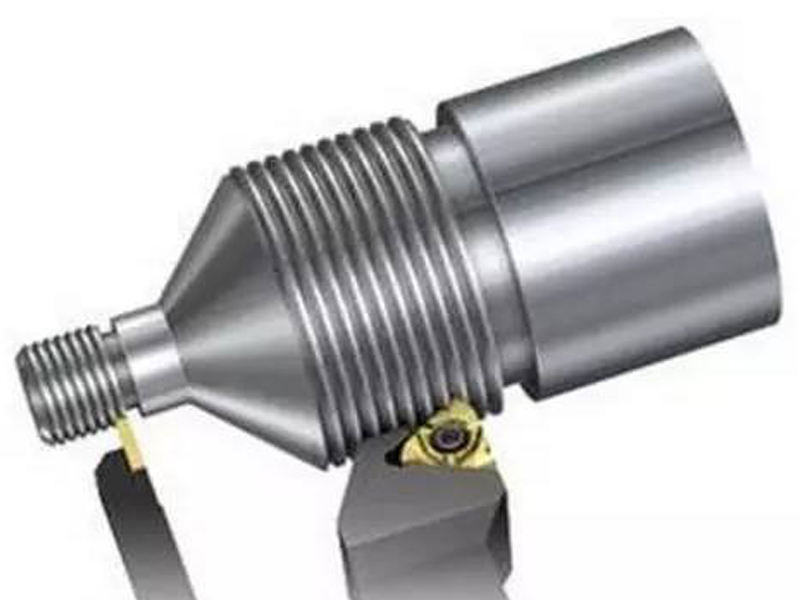Several methods of thread processing
Source:shengfe Date:2018-05-11 09:23
Several methods of thread processing

Thread turning
Turning threads on a lathe can use a turning tool or a comb (see threading tools). Turning the thread with a turning tool is a common method for producing single-piece and small-batch threaded workpieces due to the simple structure of the tool; turning the thread with a comb comb cutter has high production efficiency, but the tool structure is complex and is only suitable for medium and large batch production. Short-threaded workpiece turning fine teeth. The pitch precision of the trapezoidal thread on ordinary lathes generally can only reach 8 to 9 (JB2886-81, the same below); the thread can be machined on a specialized threaded lathe, and the productivity or precision can be significantly improved.
Thread milling
Milling with a disk or comb cutter on a thread milling machine. Disc cutters are mainly used for milling trapezoidal threads on workpieces such as screws and worms. Comb milling cutters are used to mill internal and external common threads and taper threads. Because they are milled with a multi-edged cutter, the length of the working part is longer than the length of the thread being machined, so the workpiece can be processed only by rotating 1.25 to 1.5 revolutions. Completed, high productivity. The pitch precision of thread milling can generally reach 8-9 grades, and the surface roughness is R5-0.63 microns. This method is suitable for batch production of general-precision threaded workpieces or roughing before grinding.
Thread grinding
It is mainly used for precision threading of hardened workpieces on a thread grinder. It can be divided into two types according to the shape of the grinding wheel: single-line grinding wheel and multi-line grinding wheel. The precision of pitch that can be achieved by single-line grinding wheel is 5-6, and the surface roughness is R1.25-0.08 micron. The dressing of grinding wheel is more convenient. This method is suitable for grinding precision screw, thread gauges, worms, small batches of threaded workpieces and sharpening hobs. Multi-line grinding wheel grinding vertical grinding method and cut into two kinds. The grindstone width of the longitudinal grind method is less than the length of the grinded thread. The grindstone can move the grindstone longitudinally once or several times to grind the thread to the final size. The width of the grindstone that is cut into the grindstone is greater than the length of the grinded thread. The grindstone cuts into the surface of the workpiece in a radial direction. The workpiece can be grinded after about 1.25 rotations. The productivity is high, but the accuracy is slightly lower and the dressing of the grindstone is more complicated. The plunge cut method is suitable for grinding large batches of taps and grinding certain fastening threads.
Tapping and threading
Tapping is the use of a certain torque to screw the tap into the pre-drilled bottom hole of the workpiece to produce the internal thread.
The thread is made by cutting a male thread on a bar (or pipe) workpiece. The accuracy of tapping or threading depends on the accuracy of the tap or die. Although there are many methods for machining internal and external threads, the internal threads of small diameter can only be processed by taps. Tapping and threading can be done manually. Lathes, drilling machines, tapping machines and threading machines can also be used.
Thread rolling
Forming rolling molds to plastically deform workpieces to obtain threading methods Thread rolling is usually performed on a rolling machine reeling machine or on an automatic lathe attached with an automatic opening and closing thread rolling head, suitable for mass production standards External threads of fasteners and other threaded couplings. The outside diameter of the rolling thread is generally not more than 25mm, the length is not more than 100mm, and the thread precision can reach Grade 2 (GB197-63). The diameter of the blank to be used is approximately equal to the diameter of the thread to be machined. Rolling generally cannot process internal threads, but it can be used for non-grooved extrusion taps of cold-worked workpieces (maximum diameter up to 30 mm). The working principle is similar to tapping. The required torque when cold-extruding the internal thread is approximately 1 times larger than the tapping, and the machining accuracy and surface quality are slightly higher than the tapping.
